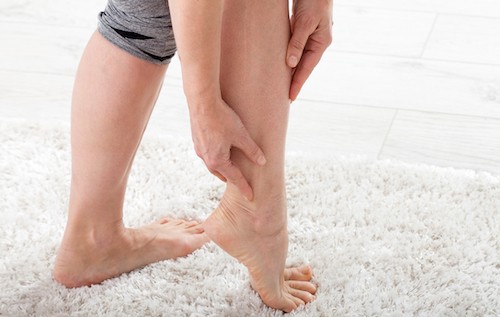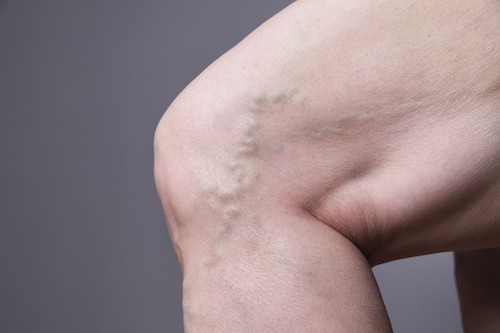The initial appearance of spider veins or varicose veins can be disappointing and disheartening. But, for many people, even though they may be chalked up to age or family predisposition and are a source of embarrassment in public, as long as they remain seen and not felt, it’s easiest to simply ignore them or hide them from view. And while it’s true that in some instances a few painless spider veins or small varicose veins remain asymptomatic, usually these initial signs indicate a problem that is likely to worsen over time, leading to discomfort and pain. Here we provide a brief guide to help you determine whether your vein problems might be more than cosmetic.
Inflammation
One of the most important triggers that leads to the formation of varicose veins is chronic inflammation in the vein walls. Inflammation happens when elevated pressure in the veins combined with poorly functioning vein valves causes turbulent blood flow. The turbulent blood flow stresses the inner lining of the vein and damages it, triggering the inflammatory process.
When inflammation is happening at a low level you may not experience noticeable discomfort. But as the underlying problem progresses greater stress is placed on the endothelium prompting a cycle of inflammation and stress. The inflammatory process is so significant that in some people, varicose veins have been found to be present below healthy, functioning valves, indicating that valve damage is a result rather than the cause of the inflammatory process[1].
As your varicose veins progress, you may or may not develop more visible bulging veins. Regardless of what you can see, under the surface, the process continues to advance. It is important to keep in mind that what may be happening in the deeper veins that are not visible at the surface may be compromising your health without your awareness and more than you think.

Leg Pain
Sometime after the visual appearance of spider or varicose veins several symptoms may begin to show up that can be taken as an indication that your vein problem is more than cosmetic. These include aching or burning sensations, muscle cramps, or a sense of heaviness in the legs. You might also develop restless legs at night. These symptoms can start to intrude on your daily routine at work and at home.
And though you might be tempted to look for other explanations or regard them as not sufficiently serious to warrant medical attention it’s best to have your veins evaluated at the earliest possible juncture. By doing so you may catch the problem early enough to avoid these more serious indicators:
Ankle Swelling
As varicose veins progress and pressure in the veins continues to rise fluids begin to leak from the veins into the surrounding tissues, leading to swelling. Generally, this swelling starts around the ankles and moves upwards. Elevating your legs will reverse the swelling and alleviate the associated pressure and discomfort, but as soon as you lower your legs the swelling returns. You might find yourself resorting to the use of compression stockings to manage this symptom.
Skin Ulcers
In advanced varicose vein conditions involving longstanding swelling, the ongoing pressure of the fluid in the legs can cause the skin to break down, forming open sores called ulcers. These usually appear around the ankles and shins where the majority of fluid accumulates. Ulcers are very challenging to treat and take many months to heal.
Skin Discoloration
In addition to fluid components of the blood leaking out and causing swelling, red blood cells can also be forced out of the veins by the elevated blood pressure. When this happens the iron-containing hemoglobin in the red blood cells degrades to a dark brownish-red color, dramatically staining the skin.

Superficial and Deep Vein Thrombosis
The most dangerous complication of varicose veins is that they increase your risk for developing blood clots, a process known as thrombosis. Superficial blood clots often resolve on their own; however, blood clots in deep veins can grow quite large. Symptoms of deep vein thrombosis include sudden pain, swelling, warmth, redness, and tenderness in the affected leg. Small pieces from a deep vein thrombus can detach and be carried away in the bloodstream eventually lodging in the lung and causing a life-threatening emergency.
We want you to know that you don’t have to suffer deteriorating health because of your varicose veins. There are simple procedures that can permanently resolve your varicose vein problems. To learn about these treatments, we invite you to schedule a free consultation at Empire Vein & Vascular Specialists.
All of our physicians are board-certified vascular surgeons who specialize in helping people like you.
Empire Vein & Vascular Specialists is the top provider of VenaSeal™, the leading outpatient varicose vein treatment, in the USA.
To schedule a free consultation, please call 1-800-827-4267 (1-800-827-4267) today.
References
- The Role of Endothelial Dysfunction and Inflammation in Chronic Venous Disease. Ann Vasc Surg, 2018. 46: p. 380-393
https://pubmed.ncbi.nlm.nih.gov/28688874